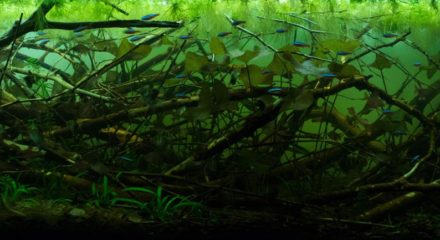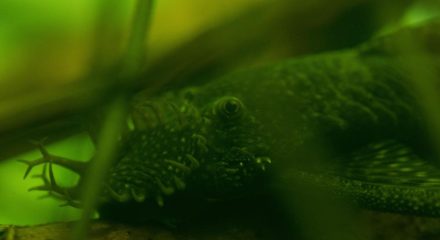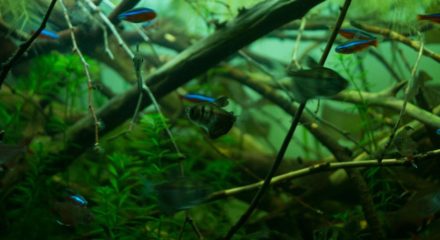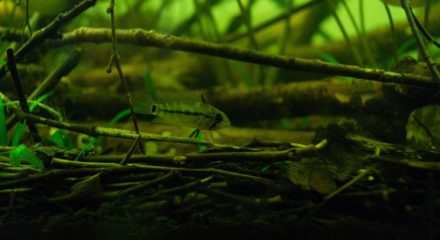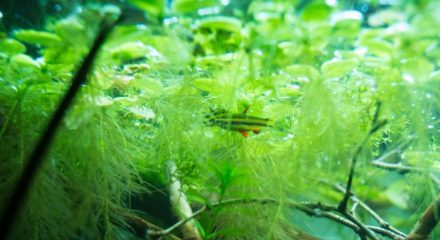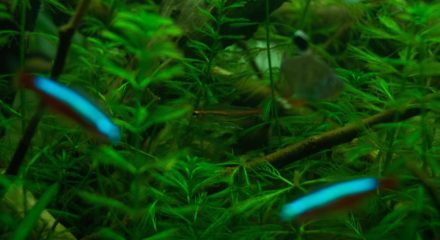Rio Unini Igarape Agua Preta, Brazil
18th place in Biotope Aquarium Design Contest 2016
![]() Russia. Kirill Shaklein
Russia. Kirill Shaklein
Aquarium Volume: 375 L
Fish and invertebrates: Paracheirodon axelrodi, Hemigrammus erythrozonus, Nannostomus marginatus, Ancistrus dolichopterus, Apistogramma sp., Gymnocorymbus ternetzi, Hyphessobrycon bentosi
Plants list: Riccia fluitans, Lemna minor, Limnobium laevigatum, Pistia stratoites, Eichhornia crassipes, Sagittaria subulata, Nymphaea sp., Myriophyllum elatinoides
Biotope description: Rio Unini is located in the municipality of Barcelos, Amazonas. It has an area of 833.352 hectares (2,059,260 acres). It extends upstream along the left (north) Unini riverbank from its mouth in the Rio Negro and then upstream along the left bank of its main tributary Agua Preta. To the east section there is “Jau” National Park and to the western part there is the reserve “Aman”. It is part of the Central Amazon. Barselos (also Barcellos) previously Mariuá, is a municipality located in the state of Amazonas, northern Brazil. Yearly number of precipitation is about 2000 millimeters (79 inches), temperature range is 14 to 39°C (57 to 102°F), average 25°C (77°F). The terrain is flat. The reserve has very diverse geology, soil, vegetation and fauna. Main river Unini has numerous meanders and floodplains, with a rich variety of aquatic environments. The vegetation includes dense tropical forest (53%), forest land (29%), igapó (11%) and campinarana (5%). The fauna of the reserve, which are endemic to the basin of the Rio Negro include Symphysodon discus and Cacajao melanocephalus. In black water of Unini there are mainly from characiformes and Siluriformes, including catfish and similar. There are three newly discovered species of fish, as well as several rare species of birds and bees here. Some species of fish, turtles and birds are at risk of excessive hunting. There is some risk from illegal fishing, mining and deforestation, but it is low in comparison with others. The bottom is light, there is a large number of fallen leaves in the coastal zone, fallen trees. In addition to the aquatic organisms that are specified and presented in my aquarium, in Unini river, since it is a tributary of the Rio Negro, there is a very large number of other aquatic organisms, such as, Cichla temensis, Petitella georgiae, Dicrossus filamentosus, Crenicihla, Acaronia, Heros, Hypselecara, Geophagus, Rio Negro Altum Angel Fish, Pygocentrus nattereri, Electrophorus electricus, Leporinus, Nanostommus eques, Potamotrygon, Carnegiella strigata, Chilodus punctatus, Cichlasoma festivum, and others. Also there are anaconda, caiman and freshwater dolphin here.
Fish and invertebrates: Paracheirodon axelrodi, Hemigrammus erythrozonus, Nannostomus marginatus, Ancistrus dolichopterus, Apistogramma sp., Gymnocorymbus ternetzi, Hyphessobrycon bentosi
Plants list: Riccia fluitans, Lemna minor, Limnobium laevigatum, Pistia stratoites, Eichhornia crassipes, Sagittaria subulata, Nymphaea sp., Myriophyllum elatinoides
Biotope description: Rio Unini is located in the municipality of Barcelos, Amazonas. It has an area of 833.352 hectares (2,059,260 acres). It extends upstream along the left (north) Unini riverbank from its mouth in the Rio Negro and then upstream along the left bank of its main tributary Agua Preta. To the east section there is “Jau” National Park and to the western part there is the reserve “Aman”. It is part of the Central Amazon. Barselos (also Barcellos) previously Mariuá, is a municipality located in the state of Amazonas, northern Brazil. Yearly number of precipitation is about 2000 millimeters (79 inches), temperature range is 14 to 39°C (57 to 102°F), average 25°C (77°F). The terrain is flat. The reserve has very diverse geology, soil, vegetation and fauna. Main river Unini has numerous meanders and floodplains, with a rich variety of aquatic environments. The vegetation includes dense tropical forest (53%), forest land (29%), igapó (11%) and campinarana (5%). The fauna of the reserve, which are endemic to the basin of the Rio Negro include Symphysodon discus and Cacajao melanocephalus. In black water of Unini there are mainly from characiformes and Siluriformes, including catfish and similar. There are three newly discovered species of fish, as well as several rare species of birds and bees here. Some species of fish, turtles and birds are at risk of excessive hunting. There is some risk from illegal fishing, mining and deforestation, but it is low in comparison with others. The bottom is light, there is a large number of fallen leaves in the coastal zone, fallen trees. In addition to the aquatic organisms that are specified and presented in my aquarium, in Unini river, since it is a tributary of the Rio Negro, there is a very large number of other aquatic organisms, such as, Cichla temensis, Petitella georgiae, Dicrossus filamentosus, Crenicihla, Acaronia, Heros, Hypselecara, Geophagus, Rio Negro Altum Angel Fish, Pygocentrus nattereri, Electrophorus electricus, Leporinus, Nanostommus eques, Potamotrygon, Carnegiella strigata, Chilodus punctatus, Cichlasoma festivum, and others. Also there are anaconda, caiman and freshwater dolphin here.
Photo Gallery
Comments of the members of the jury of Biotope Aquarium Design Contest 2016

Apart from the Gymnocorymbus ternetzi, which I cannot confirm live in that river, the biotope as a whole creates a very pleasing habitat, both for the fish and for the onlooker. The ample cover from the floating plants, water lilies, twigs and branches is very reminiscent of an Igarape (side water off the main river,) where lots of small fish take cover. I like the light and shade, mixture of natural materials and textures and am sure the fish residing within it are very happy with their décor. Love the Apistogramma, tetra and pencilfish combination. Inexpensive yet effective.

Nice layout representing a Amazonic Igarapé. Some igarapés have a big open area, but another ones looks like this layout. A lot of driftwoods, leaves and bunches inside the water. This kind of enviroment is adequade to small tetras because offer protection against big predators. Very good representation.

